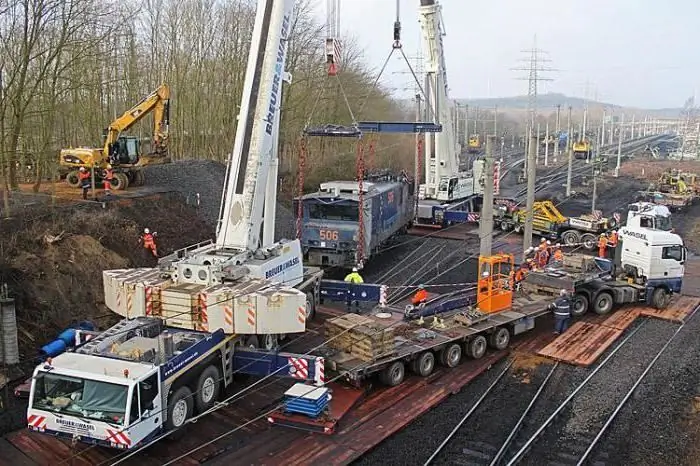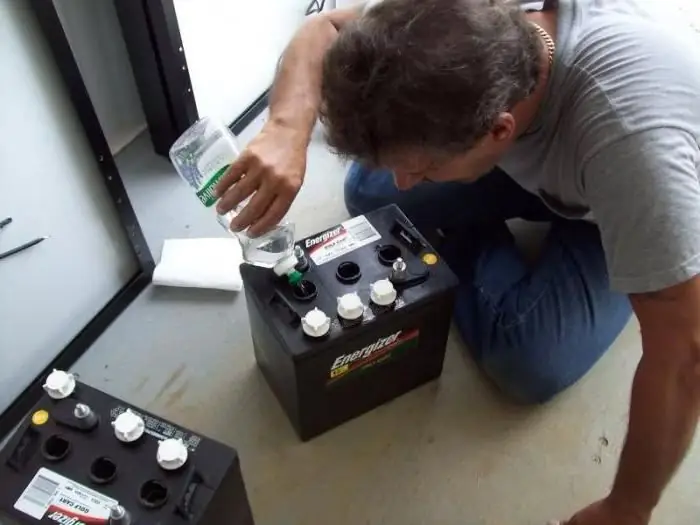2025 Author: Erin Ralphs | [email protected]. Last modified: 2025-01-22 21:14:11
A modern car battery typically lasts five to seven years. Having worked out the due date, it loses the properties of the accumulation of electricity and can fail at the most inopportune moment.
The best solution in this situation is to purchase a new battery. But if for some reason you don’t have such an opportunity, you can try to reanimate an old battery. Restoring the battery, of course, will not restore its former abilities, and it will not last as long as we would like, but such a battery will do just fine as a temporary or spare.
In this article, we will look at what car battery desulfation is and how to do it at home. But first, let's look at the reasons why a battery "gets old".

Sulfation
The basis of the design of a lead-acid battery is lattice plates. Some of them are made of pure lead, others of its oxide. The entire space between the plates is filled with an electrolyte - a solution of sulfuric acid. When a battery is being discharged, a chemical reaction takes place inside the battery, resulting inwater and lead sulfate are formed, settling on the gratings in tiny particles. This process is called sulfation. It is he who leads the battery to "aging".
When the battery goes into charging mode, the reaction is reversed, but it is never complete. In other words, sulfate particles that have not entered the process, gradually, layer by layer, cover the electrodes, rendering the battery unusable.
What causes sulfation
Naturally, the sedimentation of s alt particles on the grids at first does not affect the operation of the battery, because all this happens at the molecular level. But over time, the molecules begin to form crystals that grow continuously.

And now, after a few years of active operation, the cells of the gratings are clogged with them, and the electrolyte is no longer able to fully circulate. The result of sulfation are:
- reducing the working area of gratings;
- increase their electrical resistance;
- reducing battery capacity.
This destructive process cannot be avoided, but you should know that it happens much faster and more efficiently when the battery is not recharged for a long time.
What is desulfation
Is it possible to extend the life of the battery? The only way to save the battery is desulfation. This is the reverse process that we have already talked about. It happens on its own when the energy source gets charged. But in the battery, whichhas already worked, desulfatation does not occur under the influence of the current that the generator gives it. It can be carried out only by radical methods, which we will discuss later.

Methods for battery desulfation
How can you get rid of sulfuric acid s alts at home? Do-it-yourself battery desulfation can be done in two ways: with the help of electricity, and with the help of chemically active substances. In the first case, electrical appliances are used that are capable of supplying current of different sizes and in different modes to the battery. Chemical desulfation occurs due to the reaction of lead sulfate with industrial or homemade alkaline solutions.
Multiple charge method
This method can be applied to any type of lead-acid battery, regardless of its condition. It does not require any special knowledge in electrical engineering and chemistry. To carry it out, it is enough to have an ordinary car charger at hand.
Before starting work, check the level and quality (density) of the electrolyte. It is better, of course, to fill in a new solution in order to somehow “revive” the battery. Desulfation by the method of multiple charging involves the supply of low-value current to the contacts of the battery with short time intervals. The cycle consists of 5-8 stages, during which the battery receives a current equal to one tenth of its capacity.

During each of the charges, the voltage at the battery terminals increases, and it stops charging. During the break, the electrical potential between the electrodes equalizes. In this case, a denser electrolyte moves away from the plates. This causes the battery voltage to drop. By the end of the cycle, the electrolyte reaches the desired density, and the battery is fully charged.
Reverse charge method
The next way you can try to restore the battery is desulfation by reverse charging. It involves the use of a powerful power source capable of delivering current up to 80 A or more, as well as voltage within 20 V. A welding machine (not inverter) is perfect for these purposes. The procedure is the following. The battery is disconnected from the on-board network of the car and removed. We install the battery on a flat surface, unscrew the plugs. We connect the terminals of our impromptu charger to its contact terminals in the reverse order, i.e. to minus - plus, to plus - minus, and turn on for 30 minutes. During this process, the electrolyte will inevitably boil, but this is not scary, because we will change it.
As a result of such shock therapy, not only the desulfation of the battery plates occurs, but also a change in its polarity. In other words, a minus becomes a plus and vice versa.
After half an hour of reverse charging, the old electrolyte must be drained. After that, we pour hot water inside each jar and thus wash out the sediment formed as a result of desulfation.

Fill in a new electrolyte, put the battery on charge using a conventional charger set to a current of 10-15 A. The duration of the procedure is 24 hours.
Important: when charging the battery, observe the reverse polarity, because our battery changed it forever!
Desulphation with baking soda
If the battery is still showing signs of life, you can try a milder method of restoring it. To do this, we need clean water, preferably soft (with a minimum s alt content), a container and a heat source to heat it, as well as ordinary baking soda and a charger.
We install the removed battery on a horizontally flat surface, unscrew the plugs and drain the old electrolyte. Next, we make a solution for desulfation at the rate of 3 teaspoons of soda per 100 g of water and heat it to a boil. Pour the hot mixture into jars and let it “work” for 30-40 minutes. After that, drain the solution and rinse the battery three times with hot water.
Fill in a new electrolyte, charge the battery. Desulfation with soda, as it may seem at first glance, gives a very weak effect, but if you follow the rules of charging, then the battery will have a real chance for a second life.

At the initial stage, we charge the battery with a current of 10 A at a voltage of 14-16 V during the day. Then we repeat the procedure every day, reducing the time to six hours. The charge cycle should be exactly 10 days.
Desulfation with Trilon-B
Do-it-yourself battery desulfation can becarried out using a special tool designed specifically for this purpose. This remedy is an ammonia solution of ethylenediaminetetraacetic acid sodium (trialon-B). You can buy it at any auto shop or car market. It is poured into the battery banks for an hour, after charging it and draining the old electrolyte. The process of desulfation with trialalone is accompanied by abundant gas evolution and the appearance of small bubbles on the surface of the liquid. The cessation of these two phenomena indicates that the reaction is over and the procedure can be stopped. The final stage of desulfation is washing the jars with distilled water and filling them with a new electrolyte. The battery is charged in the usual way with a current equal to a tenth of the battery capacity.

Battery desulfation by charger
Today there are special devices on sale that allow you to charge the battery and carry out its desulfation. They are, of course, not cheap, so buying them specifically in order to restore one battery is more than impractical. But if one of your friends has such a battery desulfation device, then it is foolish not to take advantage of this opportunity. The principle of operation of this device is based on the method of multiple charging, which we talked about earlier. First, the battery is charged for some time with a current of a certain value, and then it is discharged. This is followed by a new stage, followed by another, and so on, until the battery is charged.
Desulphation of the battery with a charger having suchfunction, is the most reliable and safest method to restore it. In addition, it does not require any control - everything happens automatically. The user only needs to connect the battery to the device, select the desired mode and wait for the result.
Recommended:
Operation and maintenance of batteries. Battery repair. Car battery brands

The article is about batteries. Measures for servicing batteries, their design, varieties, nuances of operation and repair are considered
Battery recovery. Salvation or Torment?

The beginning of the 21st century amazes everyone with its discoveries and ambitious plans. Progress does not stand still, covering all large areas. Since the creation of the battery, it has undergone many changes, but to this day it is the leader among non-stationary sources
Recovery train of Russian Railways. What is a recovery train?

Many people prefer to use airlines, but the railway will not lose its relevance in the near future due to the inexpensive cost of services. But here, as in road transport, various accidents happen. Then a recovery train comes to the rescue, which promptly removes the blockages for the speedy resumption of railway traffic
How to choose a battery: rating of the best. Battery brands

Each car owner sooner or later faces the fact that his "iron horse" needs a new battery. And here comes the problem of choice. After all, the operation of the vehicle as a whole depends on the correctly selected device. The rating of car batteries is designed to help in this difficult choice
What to add to the battery - water or electrolyte? Car battery service. Battery electrolyte level

The main parts of the vehicle should include the battery. During normal operation, this battery is charged while the vehicle is running. But there are often cases when, if other devices in the car malfunction, it must be charged using a special device. Such operating conditions affect the rapid wear of the device. In addition, from time to time it needs to be refueled. Many people often get confused about what to add to the battery: water or electrolyte

